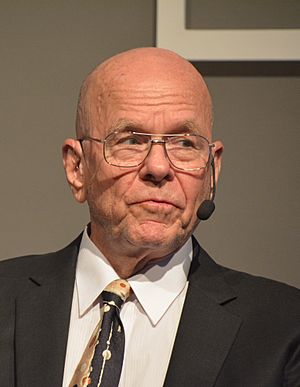Karl Barry Sharpless facts for kids
Quick facts for kids
Karl Barry Sharpless
|
|
|---|---|

Sharpless in 2018
|
|
| Born |
Karl Barry Sharpless
April 28, 1941 Philadelphia, Pennsylvania, U.S.
|
| Alma mater | Dartmouth College (BA) Stanford University (MS, PhD) |
| Known for |
|
| Spouse(s) |
Jan Dueser
(m. 1965) |
| Awards |
|
| Scientific career | |
| Fields | Stereochemistry |
| Institutions |
|
| Thesis | Studies of the Mechanism of Action of 2,3-oxidosqualene-lanosterol cyclase: Featuring Enzymic Cyclization of Modified Squalene Oxides (1968) |
| Doctoral advisor | Eugene van Tamelen |
| Doctoral students | M.G. Finn |
| Other notable students | Undergrads:
|
Karl Barry Sharpless, born on April 28, 1941, is an American chemist. He is famous for his work on how molecules are shaped and how they react. He has won the Nobel Prize in Chemistry two times! This is a very rare achievement.
He received half of the 2001 Nobel Prize for his work on "chirally catalysed oxidation reactions." These reactions help scientists make specific types of molecules. He also won one-third of the 2022 prize. This second award was for developing "click chemistry" and "bioorthogonal chemistry." Click chemistry is a way to easily join molecules together. Sharpless is one of only five people to win two Nobel Prizes.
Contents
Early Life and Education
Karl Barry Sharpless was born in Philadelphia, Pennsylvania. Growing up, he spent his summers by the Manasquan River in New Jersey. There, he developed a strong love for fishing. He even worked on fishing boats during his college summers.
He finished high school in 1959. Then, he went to Dartmouth College, earning a degree in 1963. Sharpless first thought about going to medical school. However, his research professor encouraged him to study chemistry instead. He earned his Ph.D. in organic chemistry from Stanford University in 1968. After that, he continued his research at Stanford and Harvard University.
Academic Career and Discoveries
Sharpless taught as a professor at the Massachusetts Institute of Technology (MIT) from 1970 to 1977 and again from 1980 to 1990. He also taught at Stanford University from 1977 to 1980.
While at Stanford, Sharpless made an important discovery called the Sharpless asymmetric epoxidation. This method helps chemists create molecules with a specific 3D shape. Since 1990, Sharpless has led a research lab at Scripps Research, continuing his groundbreaking work.
Amazing Chemistry Research
Sharpless developed special reactions called "stereoselective oxidation reactions." These reactions allow chemists to control the exact 3D shape of new molecules they create. He showed that these reactions could make complex molecules much more easily. His discoveries, like aminohydroxylation, dihydroxylation, and the Sharpless asymmetric epoxidation, changed how chemists build molecules.
In 2001, he received his first Nobel Prize in Chemistry. This was for his work on these "chirally catalyzed oxidation reactions." These methods are very important for making medicines and other useful chemicals.
Around the year 2000, Sharpless came up with the idea of "click chemistry." He fully described this idea with his colleagues in 2001. Click chemistry is like using "molecular LEGOs." It involves a set of simple, reliable reactions that work well under normal conditions. The most famous example is a reaction that forms 1,2,3-triazoles. These are special ring-shaped molecules. Click chemistry has become a very popular tool for scientists to quickly and easily connect different molecules.
Awards and Honors
Karl Barry Sharpless has received many awards for his scientific contributions. As mentioned, he is a two-time Nobel laureate. He won the 2001 Nobel Prize for his work on oxidation reactions. He won the 2022 Nobel Prize for developing click chemistry.
In 2001, he also received the Wolf Prize in Chemistry. This award recognized his pioneering work in creating asymmetric catalysis. This field helps scientists make specific types of molecules, which is very important for new products.
In 2019, Sharpless was given the Priestley Medal. This is the highest honor from the American Chemical Society. It recognized his invention of catalytic oxidation methods and the concept of click chemistry. He also received the Gold Medal of the American Institute of Chemists in 2023.
He is a Distinguished University Professor at Kyushu University in Japan. He also holds honorary degrees from several universities around the world.
Personal Life
Karl Barry Sharpless married Jan Dueser in 1965. They have three children together. In 1970, he had a lab accident where he lost sight in one eye. After this, Sharpless always emphasized the importance of wearing safety glasses in the lab. He believes safety should always come first for scientists.
See also
 In Spanish: Karl Barry Sharpless para niños
In Spanish: Karl Barry Sharpless para niños

